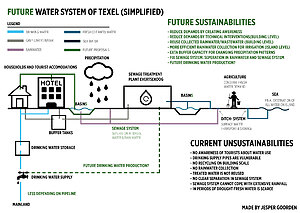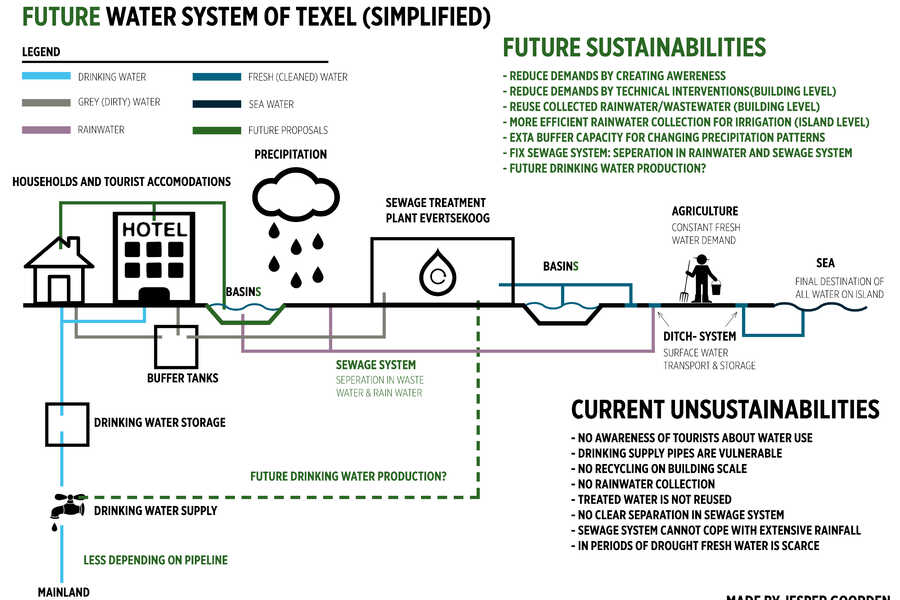
According to the current situation, the existing water treatment plant is already using a very sustainable way to clear the wastewater. However, we still think there is room for improvement. This proposal design is divided in three phases and three levels. The phases are reduce, re-use and re-cycle and the levels are personal-, building- and island level. Our main focus is on the first phase, which although it seems the most obvious concept, it is the easiest, cheaper and most efficient solution.
Water Reduction
Since Dutch water is relatively cheap (approximately 60euros/person/year), saving water won’t lead to enormous savings on the financial field. However, cleaning water consumes lots of energy, so it is important to pay attention to your water usage.
The Dutch average daily water usage, as it is analyzed above, is 120 liters per person. Washing, cleaning and flushing the toilet consumes the biggest part of this water. The reduction phase is divided in two parts: awareness on a personal level and small technological changes on a building level.
Awareness
In order to involve the Tesselaars to their new sustainable future, we will start by raising their awareness and responsibility. The campaign should teach them, as well as visitors, that just by reducing their showers by one minute, closing the tap while brushing their teeth and filling up their washing machines in order to reduce their amount of washes, they can already reduce their water use by 25%.
A special function lays with the owners of hotels and other tourist accommodations; they will not only be responsible for their own water use but must also inspire their guests to do so. This should be done in a similar way to the cards we're already familiar with in hotels that tell you to re-use your towel.
Info graphics or informative meetings should provide the inhabitants and tourists with tips in order to save drinking water. Small changes on a large scale can have big impacts.
Some of these small changes could be:
- Taps run with approximately 12 L/min, so don't forget to close it in between actions. Closing the tap while you brush your teeth, for one minute, twice a day, will save 20% of your water usage!
- Leaking taps can consume enormous amounts of water; by checking all taps in your house you can prevent unnecessary waste of water. A dripping tap often wastes around 5 liters a day, a leaking toilet sometimes even 300 liters a day.
- Showering 1 minute less, assuming you shower on a daily basis, will reduce your water use by more than 7%.
- A bath consumes twice as much water (110 L) compared to a five-minute shower.
- Fill up the (dish) washing machine in order to use it as efficiently as possible. An average dishwasher uses 22,5 liters each turn, a clothes washing machine even 150 L. Assuming that by filling your machine you can prevent one wash a month and one dish a week you'll save 240L of water in a month, 8L of water per day, so another 7%.
Technological changes
To enhance the water savings on a building level, several small technological changes can be incorporated to the existing building system. We are proposing two packages, the basic (low-cost solution for existing building) and the advanced, which can reduce the consumed water 20 and 40% respectively.
Basic Package: The basic package is referred to existing buildings. It costs 70 euros, saving 20% of consumed water and includes:
1. Water saving showerheads, which consume 5 L/min instead of 8,7 without a reduction in comfort. Specifically, water saving tap heads can save up to 3000 L/year and cost only 2 euros.
2. Toilet Displacement Devices: Plastic containers (such as plastic milk jugs) can be filled with water or pebbles and placed in a toilet tank to reduce the amount of water used per flush. By placing one to three such containers in the tank, more than 3,8 liters of water can be saved per flush, which is translated in 18liters/person/day and 6570liters/person/year. This device cost only 5euro.
3. A simple water harvesting system, which will collect the rainwater from the roofs of each building and then storage it in a water tank outside of the building can be easily installed. This rainwater can be used for irrigation and other outside activities like washing cars etc. can save 1500L/year. The needed equipment consists of the existing roof, pipes and a water tank of 300liters with a total cost of 50 euros.
Advanced Package: This package is for new or renovated building, aiming to save 40% and incorporating new modern devices such as washing machines and toiles with grey water systems combined and precipitation collection.
1. Modern toilets: Older toilet cisterns with a syphon-flushing system hold between 9 litres and 12 litres of water. Modern toilet cisterns hold about 6 litres of water.
2. Modern washing machines, both for clothes and dishes, are often much less energy and water consuming
3. Heat exchangers can be applied to make use of the waste heat after a shower.
4. The use of waste water for flushing toilets, which can safe 25% of the yearly water consumption.
5. Rainwater harvesting: The roof of an average Dutch house catches 80.000 liters of rainwater on a yearly basis, this is nearly enough for an average two person household. Rainwater harvesting is beneficial because provides an independent water supply during regional water restrictions by reducing the existing water supply and simultaneously providing water during the whole year, especially in drought seasons by reducing the run-off, the erosion and the contamination of surface water.
Water Re-use
As we've seen Texel deals with large amounts of atmospheric precipitation. Collecting and using this fresh water can reduce tap water use to a large extend. This phase is mainly applicable to the re-use of the rainwater on the building (as it is already mention in previews phase) and island level, creating grey water for uses such as filling swimming pools, showers and washing machines on camp sides and in general for all other taps which aren't used for drinking water.
Re-cycle
The last step to provide independency for the Tesselaars is to create their own drinking water cleaning facility. However, there are still no good, legal methods for this, making it a future goal.


